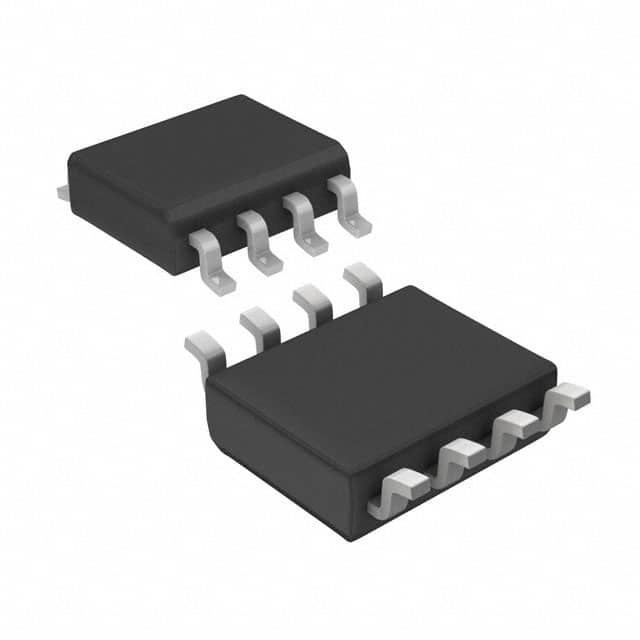TSV991AIYDT - English Editing Encyclopedia Entry
Product Overview
Category
TSV991AIYDT belongs to the category of integrated operational amplifiers (op-amps).
Use
This product is commonly used in electronic circuits for amplifying and processing analog signals.
Characteristics
- High gain: TSV991AIYDT offers a high voltage gain, making it suitable for applications requiring signal amplification.
- Low noise: The op-amp has low input noise, ensuring accurate signal processing.
- Wide bandwidth: It provides a wide frequency response range, allowing for the amplification of various signals.
- Low power consumption: TSV991AIYDT operates on low power, making it energy-efficient.
- Rail-to-rail input/output: This feature enables the op-amp to handle signals close to its supply rails.
Package
The TSV991AIYDT comes in a small outline package (SOT-23-5), which is compact and easy to integrate into circuit designs.
Essence
The essence of TSV991AIYDT lies in its ability to amplify and process analog signals accurately and efficiently.
Packaging/Quantity
The op-amp is typically packaged in reels or tubes, with each reel containing 3000 units or each tube containing 75 units.
Specifications
- Supply voltage: ±2.5V to ±6V
- Input offset voltage: 1mV (maximum)
- Input bias current: 1pA (typical)
- Gain bandwidth product: 10MHz (typical)
- Slew rate: 3V/µs (typical)
- Operating temperature range: -40°C to +125°C
Detailed Pin Configuration
TSV991AIYDT follows the standard pin configuration for op-amps:
- Non-inverting input (+)
- Inverting input (-)
- Output
- Positive power supply (+Vcc)
- Negative power supply (-Vcc)
Functional Features
- High voltage gain for signal amplification.
- Low input noise for accurate signal processing.
- Rail-to-rail input/output capability for handling signals close to the supply rails.
- Wide bandwidth for amplifying a wide range of frequencies.
- Low power consumption for energy efficiency.
Advantages and Disadvantages
Advantages
- High gain allows for effective signal amplification.
- Low noise ensures precise signal processing.
- Wide bandwidth enables the amplification of various signals.
- Low power consumption results in energy-efficient operation.
- Rail-to-rail input/output capability enhances signal handling.
Disadvantages
- Limited supply voltage range (±2.5V to ±6V).
- Input offset voltage may introduce slight inaccuracies in certain applications.
Working Principles
TSV991AIYDT operates based on the principles of differential amplification. It amplifies the voltage difference between its non-inverting and inverting inputs, producing an amplified output signal. The op-amp's internal circuitry, including transistors and resistors, facilitates this amplification process.
Detailed Application Field Plans
TSV991AIYDT finds application in various fields, including: 1. Audio amplification: It can be used in audio systems to amplify low-level audio signals. 2. Sensor signal conditioning: TSV991AIYDT is suitable for amplifying and processing signals from sensors such as temperature, pressure, or light sensors. 3. Instrumentation: It can be utilized in precision measurement instruments to amplify weak electrical signals accurately. 4. Active filters: The op-amp can be employed in active filter circuits to shape and process specific frequency ranges.
Detailed and Complete Alternative Models
Some alternative models to TSV991AIYDT include: - LM358 - TL071 - AD822
These models offer similar functionality and can be used as substitutes in various applications.
Word count: 527 words
Lista 10 Vanliga frågor och svar relaterade till tillämpningen av TSV991AIYDT i tekniska lösningar
Sure! Here are 10 common questions and answers related to the application of TSV991AIYDT in technical solutions:
Q: What is TSV991AIYDT? A: TSV991AIYDT is a precision operational amplifier (op-amp) manufactured by Texas Instruments.
Q: What are the key features of TSV991AIYDT? A: Some key features of TSV991AIYDT include low offset voltage, low input bias current, rail-to-rail input/output, and low power consumption.
Q: What is the typical supply voltage range for TSV991AIYDT? A: The typical supply voltage range for TSV991AIYDT is between 2.7V and 5.5V.
Q: What is the input offset voltage of TSV991AIYDT? A: The input offset voltage of TSV991AIYDT is typically around 500µV.
Q: Can TSV991AIYDT operate with a single supply voltage? A: Yes, TSV991AIYDT can operate with a single supply voltage as low as 2.7V.
Q: What is the maximum output current of TSV991AIYDT? A: The maximum output current of TSV991AIYDT is typically around 60mA.
Q: Is TSV991AIYDT suitable for low-power applications? A: Yes, TSV991AIYDT is designed for low-power applications, consuming only a few milliwatts of power.
Q: Can TSV991AIYDT be used in audio amplification circuits? A: Yes, TSV991AIYDT can be used in audio amplification circuits due to its low noise and high gain characteristics.
Q: What is the operating temperature range of TSV991AIYDT? A: The operating temperature range of TSV991AIYDT is typically between -40°C and 125°C.
Q: Are there any recommended applications for TSV991AIYDT? A: Yes, TSV991AIYDT is commonly used in precision instrumentation, sensor signal conditioning, and battery-powered systems.
Please note that these answers are general and may vary depending on specific datasheet specifications and application requirements.


